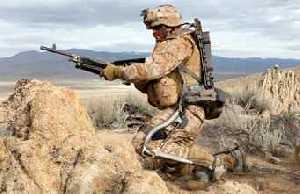Articles >>
Lockheed Martin Conducts Validation Testing On the Advanced Ruggedized HULC™ Robotic Exoskeleton
Category: Robots

ORLANDO, FL -- Lockheed Martin recently began laboratory testing of an improved next-generation design of its HULC™ advanced robotic exoskeleton. The testing brings HULC a step closer to readiness to support troops on the ground and others who must carry heavy loads.
HULC is an untethered, battery powered, hydraulic-actuated anthropomorphic exoskeleton capable of performing deep squats, crawls and upper-body lifting with minimal human exertion. It is designed to transfer the weight from heavy loads to the ground through the robotic legs of the lower-body exoskeleton, taking the weight off of the operator. An advanced onboard micro-computer ensures the exoskeleton moves in concert with the operator. The ruggedized HULC system incorporates multiple design changes to increase reliability and performance in operational environments. New environmental sealing and packaging give the system’s electronics increased protection from natural elements and battlefield hazards. Lockheed Martin also leveraged commonly-used, military-standard rechargeable batteries to increase operational run time. The testing now under way will validate the ruggedized system’s capabilities and reliability in a variety of simulated battlefield conditions. “Each of Lockheed Martin’s enhancements to the ruggedized HULC design was carefully planned to maintain peak system performance and alleviate physical burdens that can hinder the user’s mission success,” said Rich Russell, director of Sensors, Data Links and Advanced Programs at Lockheed Martin Missiles and Fire Control. “The design improvements we implemented on the ruggedized exoskeleton prove our commitment to providing the Warfighter with an innovative solution that improves endurance and reduces the risk of injury.” Lockheed Martin further refined the HULC’s form and fit, allowing the operator to adapt to the exoskeleton in less time. The ruggedized structure allows for rapid, repeatable adjustments to the torso and thigh length, without special tools, to better suit a wider variety of users. It also conforms to the body and incorporates lumbar padding for comfort and support. Additionally, the upgraded HULC features improved control software to better track the user’s movements. Biomechanical, dynamic load and environmental verification evaluations of the ruggedized HULC are under way. Treadmill testing will measure anticipated decreases in metabolic cost as the HULC assists the user with heavy loads. Sand, wind, rain, temperature and humidity testing will replicate harsh environments and verify combat durability. HULC is one of several technologies that Lockheed Martin is developing to support ground Soldiers. Lockheed Martin is a total systems solution provider to the military, including wearable situational awareness, a broad range of mobility assistance systems and power management systems. Lockheed Martin is also exploring exoskeleton designs to support industrial and medical applications. Headquartered in Bethesda, Md., Lockheed Martin is a global security company that employs about 133,000 people worldwide and is principally engaged in the research, design, development, manufacture, integration and sustainment of advanced technology systems, products and services. The Corporation’s 2009 sales from continuing operations were $44.0 billion. |
Lockheed Martin |
Lockheed Martin Autonomous Driving System Tops 55,000 Miles in Extended Army Testing
30.11.2017
SAAB Chosen As Sub-Contractor For The Ajax Virtual Crew Turret Trainer
14.10.2017
Lockheed Martin Electro-Optical Systems
Lockheed Martin Vought Systtems Corporation
Lockheed Martin Missiles and Fire Control
Discuss
